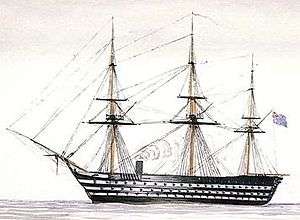HMS Marlborough (1855)
 HMS Marlborough, sketched in the Mediterranean by an anonymous artist - She is running under steam alone, and flying the Blue Ensign. (NMM) | |
| History | |
|---|---|
| Name: | HMS Marlborough |
| Builder: | Portsmouth Dockyard |
| Launched: | 31 July 1855 |
| Renamed: | Vernon II in March 1904 |
| Reclassified: | Training ship in 1878 |
| Fate: |
|
| General characteristics | |
| Class and type: | 131-gun (later 121-gun ) first-rate ship of the line |
| Displacement: | 5,892 / 6071 tons |
| Length: | 240 ft (73 m) |
| Beam: | 61 ft (19 m) |
| Propulsion: | Sails and 780 hp steam powered screw propeller |
| Speed: | 10.15 kt |
| Armament: |
|
HMS Marlborough was a first-rate three-decker 131 gun screw ship built for the Royal Navy in 1855. She was begun as a sailing ship of the line (with her sister ships HMS Duke of Wellington, HMS Prince of Wales and HMS Royal Sovereign), but was completed to a modified design and converted to steam on the stocks.
She served as flagship of the Mediterranean Fleet from 1858-64 (with the flag of Vice-Admiral William Fanshawe Martin, captain William Houston Stewart, from 3 May 1860 to 20 April 1863; and of Vice-Admiral Robert Smart, Captain Charles Fellowes, from 1863). In 1864 she was replaced as flagship by Victoria. She sailed back to Portsmouth to serve as a receiving ship (e.g. for the Steam Reserve in c.1890, as tender to HMS Asia) and as a training ship for engineers (c. December 1878). Whilst at Portsmouth, she was down-graded in rating to a 98 gun ship (in c. 1870).
For a time her Commander was Sir Edward Dolman Scott (1826–1905), 6th Baronet Scott of Great Barr.[1]
In 1904 Marlborough was moved to Portchester Creek and renamed Vernon II, becoming an accommodation hulk to the shore establishment HMS Vernon. (Vernon I was the joint name for the establishment's two existing hulks, HMS Ariadne and HMS Actaeon - all three hulks were joined together by bridges.)
Marlborough was sold to A. Butcher for breaking up in October 1924, but capsized and sank with the loss of four men on 28 November 1924 off Selsey while being towed to the breakers at Osea Island.
References
- Colledge, J. J.; Warlow, Ben (2006) [1969]. Ships of the Royal Navy: The Complete Record of all Fighting Ships of the Royal Navy (Rev. ed.). London: Chatham Publishing. ISBN 978-1-86176-281-8. OCLC 67375475.
- ↑ Allen, Peter (2011-06-10). Great Barr Observer: 8. Missing or empty
|title=(help)